Review Hi-tec Whistler Anti Shock Trekking Hiking Poles
Serious hikers take known the benefits of trekking poles for decades. Aside from providing stability while hauling a heavy load or moving over technical terrain, hiking poles accept distinct advantages even on like shooting fish in a barrel trails. They're neat for setting a rhythm and significantly reduce load and bear upon on hips, knees, and ankles when going downhill. Equally with nearly hiking and backpacking gear, balancing weight and durability is the most common consideration. Below are our acme trekking pole picks of 2022, which comprehend the gamut from ultralight and folding models to sturdy designs for high-mountain adventures. For more than background information, see our comparing table and buying advice below the picks.
Our Team's Trekking Pole Picks
- Best Overall Trekking Pole: Black Diamond Trail Ergo Cork
- Best Upkeep Trekking Pole: REI Co-op Trailbreak
- Best Ultralight Collapsible Pole: Black Diamond Distance Carbon Z
- Best Shock-Arresting Trekking Pole: Leki Legacy Low-cal AS
- Best 4-Flavor Trekking Pole: Black Diamond Alpine Carbon Cork
Best Overall Trekking Pole
1. Black Diamond Trail Ergo Cork ($140)
 Weight per pair: ane lb. 2 oz.
Weight per pair: ane lb. 2 oz.
Blazon: Telescoping (lever lock)
Shaft material: Aluminum
Grip: Cork
What nosotros similar: Solid structure, comfy feel, and proficient price.
What we don't: A piffling heavy and long collapsed length.
The carbon cobweb and folding designs that go all the attention in the trekking pole market are impressive innovations, but for hikers that just desire a pair of trustworthy sticks at a practiced cost, we recommend the Black Diamond Trail Ergo Cork. At $140, they're a solid value and come with very few compromises. In fact, the all-aluminum construction is only a few ounces heavier than most of the carbon options below merely withal plenty sturdy for most dirt, rock, and snow travel. The Trail also has Blackness Diamond's comfortable, ergonomically shaped cork grips and reliable FlickLock length adjusters.
What are the downsides of the Trail Ergo? For travelers, climbers, or those that prioritize collapsibility, the 27-inch minimum length may be an result. It shouldn't get in the way when strapped to the outside of a pack, but it is a couple inches longer than many other three-section designs (and information technology tin't come close to a true collapsible pole). As downsides go, that'south pretty insignificant for virtually folks, and the Trail Ergo Cork stands out as our favorite all-effectually trekking pole. For a cheaper but slightly less comfortable and premium option in this category, run across REI'due south Traverse poles below.
See the Black Diamond Trail Ergo Cork See the Women's Black Diamond Trail Ergo Cork
Best Budget Trekking Pole
2. REI Co-op Trailbreak ($70)
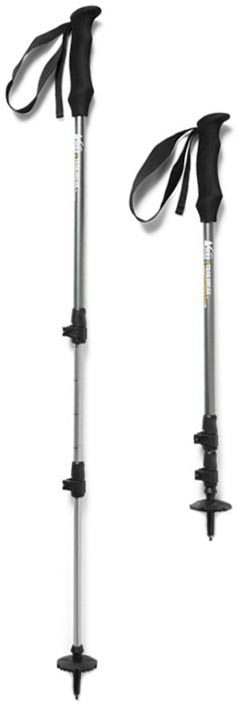 Weight per pair: 1 lb. 1 oz.
Weight per pair: 1 lb. 1 oz.
Blazon: Telescoping (lever lock)
Shaft material: Aluminum
Grip: Rubber
What we like: Cheap yet functional.
What we don't: No-frills design isn't ideal for serious hikers or tough terrain.
REI Co-op's Trailbreak line targets the budget terminate of the market place and includes everything from sleeping pads and numberless to backpacks. The Trailbreak trekking pole is the brand'south cheapest offer and has nigh all the features that get-go and occasional hikers need. You go an aluminum build, a telescoping design with lever locks, and a rubber grip. Nothing is premium here—no carbon, no cork grip, no padded wrist strap, and the locks are about as minimal as they come. In addition, the Trailbreak is only fabricated in ane size, although it is adaptable from 41 to 55 inches. But at $seventy, it's tough to vanquish the low price.
What do you sacrifice with the REI Trailbreak? Sturdiness is a large concession, and for heavy utilise and difficult terrain, these poles pale in comparison to the build of a more rugged model like the Black Diamond Trail Ergo. And equally nosotros touched on above, the Trailbreak is light on features, so yous miss out on useful touches including choke-up extensions and longer-lasting materials like cork handles and burlier and more reliable lever locks (REI's own $110 Traverse below includes those upgrades). If you lot stick to established trails and are looking for the basics in balance and back up, the Trailbreak will certainly do the trick. Merely more than serious hikers and backpackers may want to purchase a higher-stop model. For other well-built budget options, bank check out Black Diamond'south Trail Sport 2 and Trail Explorer 3.
Encounter the REI Co-op Trailbreak
Best Ultralight Collapsible Pole
3. Black Diamond Distance Carbon Z ($170)
 Weight per pair: 10 oz.
Weight per pair: 10 oz.
Type: Folding
Shaft fabric: Carbon
Grip: Cream
What we like: Incredibly lightweight and folds down small-scale.
What we don't: Pricey and carbon is more brittle than aluminum.
At around 10 ounces per pair depending on the size, the Distance Carbon Z is Black Diamond'due south lightest trekking pole and great for minimalists (they are so light and packable that they've fifty-fifty go pop with long-distance trail runners). We love the Z-Pole technology: a sleeve on the top portion moves down from the grip, the sections slide together and connect, and a small button pops everything into place. From compacted to deployed is a two-second affair, and when complanate, the poles are almost 10 inches shorter than most telescoping designs. This tin make a substantial difference for everyone from travelers and hikers wanting to store them in their bag to ultra-distance runners that carry their poles for extended stretches.
What are the downsides of these poles? Carbon is lighter than aluminum but also more expensive and brittle (it'll snap under heavy pressure rather than bend similar aluminum). In addition, the Carbon Z comes in four length options but is non adaptable. Changing upwardly your trekking pole length on the uphill or downhill is a nice feature, and the fixed length makes them less versatile in terms of letting other people apply them. If you practice value adaptability, Blackness Diamond makes the Carbon FLZ that has one FlickLock at the pinnacle for $xxx more and with a minor weight penalization. Finally, you give up some rigidity with the BD's collapsible design, and so thru-hikers looking for better long-term durability should bank check out the telescoping Gossamer Gear LT5 below.
See the Black Diamond Distance Carbon Z
Best Shock-Arresting Trekking Pole
4. Leki Legacy Lite AS ($120)
 Weight per pair: 1 lb. ii.iv oz.
Weight per pair: 1 lb. ii.iv oz.
Type: Telescoping (lever lock)
Shaft material: Aluminum
Grip: Cork/rubber
What we like: Leki's anti-shock engineering helps accept the sting out of impacts.
What nosotros don't: More than moving parts than standard trekking poles.
Right off the bat, we'll notation that nosotros typically don't recommend trekking poles with serious daze-arresting engineering—they generally are heavier, more than complex, and shock absorption isn't necessary for many. That said, for hikers who want a little extra bear upon resistance on the trail, Leki's Legacy Lite AS is worth a expect. These poles utilize Leki's DSS (Dynamic Pause System) technology to take some of the sting out of rough terrain, which can assist reduce stress on the knees and wrists during long descents. Like most of Leki'due south offerings, the Legacy is too reasonably light at just over a pound per pair, well-built with premium touches like reliable lever locks and ergonomic cork grips, and hardwearing with a total aluminum structure.
If it isn't already abundantly clear, Leki and Black Diamond dominate the trekking pole marketplace, and BD's Trail Pro Shock below was also in the running for this spot. Why did we opt for the Legacy? Namely, the Leki is lighter by around 2 ounces per pair, cheaper by $twoscore, and boasts a slightly more premium structure including the same cork grips (the Trail Pro Shock uses foam). Again, both options take more moving parts that can interruption or neglect over time, and we'd only recommend dedicated shock-absorbing poles for hikers that need the added impact cushioning. If yous've struggled in the past with musculus or joint pain, however, it's worth giving the Leki Legacy Light a try.
Run across the Leki Legacy Calorie-free As
Best 4-Season Trekking Pole
five. Black Diamond Alpine Carbon Cork ($190)
 Weight per pair: 1 lb. i.one oz.
Weight per pair: 1 lb. i.one oz.
Type: Telescoping (lever lock)
Shaft cloth: Carbon
Grip: Cork
What we like: Fantastic build quality, durable, and easy to trust in rough terrain.
What we don't: Overkill for most 3-season uses and very pricey.
For those wanting a unmarried pair of poles for all iv seasons, ranging from summer backpacking trips to backcountry skiing and mountaineering, nosotros turn once more to Black Diamond and their proven Alpine drove. Compared to the picks above, the Alpine Carbon Cork feels noticeably more than substantial in your manus, and its beefed-upwards construction isn't prone to flexing under heavy strain. In addition, Blackness Diamond outfitted the model with all their elevation-end components, including the trustworthy metal FlickLock Pro lever locks (the vast majority of designs use plastic), premium cork handles with cream extensions, and a full three-piece carbon fiber build. You pay extra for the poles at $190, but it'due south hard to knock the quality or reliability of the pattern.
Where does the Black Diamond Tall Carbon come up upwards brusk? In addition to cost, the poles are realistically overkill for many users. Even for winter adventures like snowshoeing, a cheaper option like Black Diamond'southward own Trail Ergo to a higher place will do the trick (merely option upwardly a pair of wider snow baskets to keep them from sinking also deeply in soft snow). Farther, the BDs don't pack downward equally small as designs like Leki's Micro Vario Cor-Tec TA beneath, which can exist an consequence for those needing to strap their poles to the outside of a pack. That said, nosotros establish the Alpine Carbon model to be sturdier and better suited for rough uses similar ski touring and splitboarding, which is why information technology wins out as our top twelvemonth-round option.
See the Black Diamond Alpine Carbon Meet the Women's BD Alpine Carbon
Best of the Balance
six. Gossamer Gear LT5 ($195)
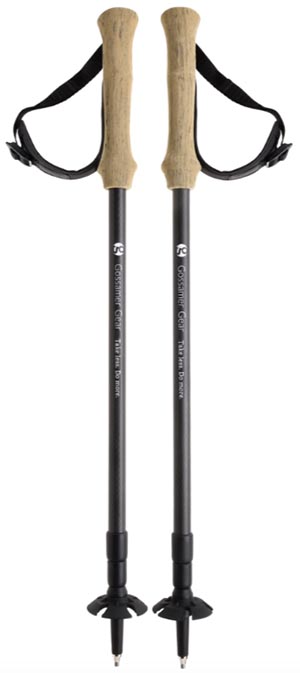 Weight per pair: 10.6 oz.
Weight per pair: 10.6 oz.
Type: Telescoping (twist lock)
Shaft cloth: Carbon
Grip: Foam
What nosotros like: Incredibly lightweight, well-made.
What nosotros don't: Non as well durable; expensive.
Taking the telescoping lightweight crown is the thru-hike-ready Gossamer Gear LT5. These carbon fiber sticks are listed at an incredibly low x.6 ounces for the pair (you lot can save even more weight by ditching the straps), which keeps arm fatigue to an absolute minimum. Unlike the folding BD Distance Carbon Z above, the LT5's telescoping pattern as well adds some sturdiness for uses like pitching an ultralight shelter. Combined with a uncomplicated, reliable build and comfy foam grips, and y'all get the ideal hiking poles for long adventures where every ounce matters. They're as well adaptable, although the twist lock system isn't our favorite (we adopt the added security of a lever lock).
Naturally, there are a few compromises in making the LT5 so calorie-free. To start, relative to the remainder of the market place, these poles aren't super durable—information technology's best to stick to established trails and avoid too much snow. Further, they're a pricey investment at $195 because their relatively uncomplicated feature gear up (the similarly expensive Altitude Carbon Z above, for case, can exist folded into a much smaller length). And finally, stock has been hit or miss lately, and the poles are sold out at the time of publishing. But if you accept practiced care of them and don't demand them for travel, they're virtually every bit skillful as information technology gets for an ultralight build. Information technology's worth noting that Gossamer Gear offers replacement sections of their poles should you damage one, which is a rarity in the market.
Meet the Gossamer Gear LT5
seven. REI Co-op Traverse ($110)
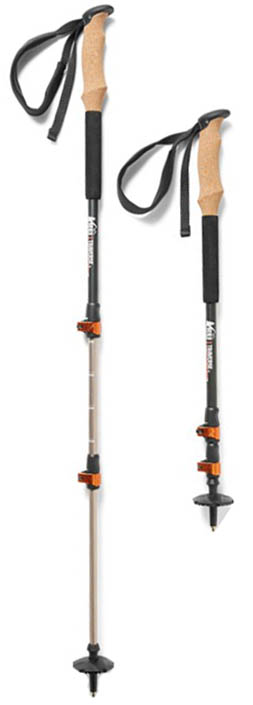 Weight per pair: 1 lb. 2.5 oz.
Weight per pair: 1 lb. 2.5 oz.
Blazon: Telescoping (lever lock)
Shaft material: Aluminum
Grip: Cork
What nosotros similar: Sturdy feel; cork and lever locks at a keen price.
What nosotros don't: A trivial heavy and falls short of the Trail Ergo Cork in a few areas.
REI'south Trailbreak above is their upkeep offering, simply the $40-pricier Traverse here provides a sizable boost in performance for more than demanding hiking and backpacking trips. All in all, it'due south a competitive mid-range choice: You get a tough, sturdy, and reliable experience from the aluminum build—it doesn't flex or bend like cheaper or ultralight options – and comfort is good cheers to the cork handle. And REI made some notable upgrades to the latest version, including foam extensions for climbing steep hills and nicer, cam-style lever locks. Added up, it's a solid all-around effort and still another great value from the brand.
The Traverse is a strong budget alternative to our acme-rated Black Diamond Trail Ergo Cork, with a like weight, 3-section telescoping design, and aluminum shaft. However, a few small nitpicks push button information technology downwards our list. In particular, nosotros found the Traverse to be a pace down in accommodating material quality (from the cork to the straps), and the BD offers a more comfy feel. Nosotros likewise prefer the Trail's ergonomic grips, which are angled slightly forwards to mimic the natural resting position of your hands. But many hikers will observe these differences difficult to discern, and the REI go the clear edge in price.
See the REI Co-op Traverse
8. Black Diamond Trail Dorsum ($xc)
 Weight per pair: 1 lb. iv oz.
Weight per pair: 1 lb. iv oz.
Type: Telescoping (lever lock)
Shaft fabric: Aluminum
Grip: Safety
What we like: Proven toughness, skillful all-around abilities.
What nosotros don't: Rubber grips aren't the most comfortable.
Every bit a market leader, Black Diamond has a adequately extensive trekking pole line-up. A consequent favorite is their budget-oriented Trail Back, which in many ways is a trimmed-downwardly version of the Trail Ergo Cork in a higher place. You lose the ergonomic shape and cork grips, but the two trusty FlickLocks remain, as well equally the sturdy aluminum construction. Further, among the options at under $100, the Trail Backs take a longer track record of durability than the REI Trailbreak above (simply do toll $twenty more than).
What are you giving upwardly with a mid-range pole like the Trail Back? To beginning, they are rather heavy at i pound iv ounces for the pair and therefore non a top option for long-distance backpackers or thru-hikers. Also, the prophylactic grips are a definite footstep downwards in comfort from foam or cork, which exercise a improve job absorbing sweat and preventing chafing while on the trail. But the Trail Back'south strong, no-nonsense construction makes a lot of sense for those looking to continue cost in check while not sacrificing much in terms of quality.
Run across the Black Diamond Trail Back
9. REI Co-op Wink Carbon ($149)
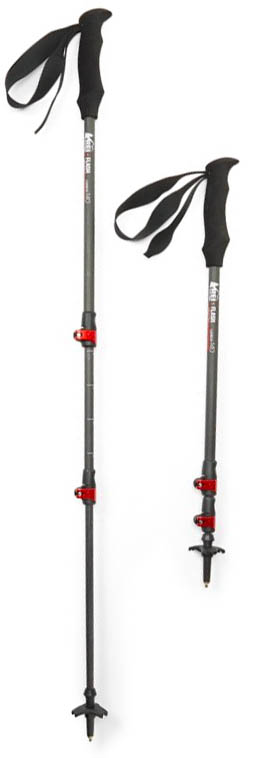 Weight per pair: xiii.6 oz.
Weight per pair: xiii.6 oz.
Blazon: Telescoping (lever lock)
Shaft material: Carbon
Grip: Foam
What we like: Excellent value for the specs and quality.
What nosotros don't: Non equally tough as our top picks.
For backpackers looking to keep weight to a minimum, the REI Co-op Flash Carbon poles are a great choice, undercutting other high-end competitors by $twenty or more than. At well nether a pound and with a carbon composite build, the poles feel calorie-free in the hands and feature soft foam grips that accept the sting out of impacts and practice a decent job at minimizing sweat buildup. Nosotros yet give the overall edge in comfort to cork, merely foam does absorb and dissipate moisture well when it'south hot and humid exterior. And nosotros like that REI utilizes a quality, metal lever lock system, which is a more secure and robust upgrade from the previous plastic version.
All that said, the Flash Carbon's lightweight build does come with one major drawback: lack of versatility. For example, BD's Trail Ergo Cork, Trail Back, and even their Alpine Carbon Cork higher up are noticeably sturdier and more confidence-inspiring for navigating rough and rocky terrain. And the Flash Carbon is decidedly less suitable for 4-season adventuring, which is confirmed past the lack of snow baskets (for reference, REI's own Traverse in a higher place does come with them). But this likely won't faze most fair-weather condition backpackers and hikers, and with REI'south splendid return policy to back them up, the Flash Carbon poles are a nice UL option.
Come across the REI Co-op Flash Carbon
10. Leki Micro Vario Cor-Tec TA ($140)
 Weight per pair: one lb. 4.3 oz.
Weight per pair: one lb. 4.3 oz.
Type: Folding (lever lock)
Shaft material: Aluminum
Grip: Cork/Safe
What we like: Collapsible to fifteen.5 inches.
What we don't: Heavy for a folding model.
With a folding-style design, Leki's well-loved and ergonomic cork grips, and a competitive toll of $140, the Micro Vario Cor-Tec TA is one of our favorite poles in this category. This aluminum model folds down to a mere 15 inches, which is among the smallest on our listing. And we dear Leki'due south SpeedLock ii locking arrangement—it tin can be tightened with a small dial, no actress tools needed. The ability to easily keep the locks tight adds to the already durable nature of these poles.
As expected, there are tradeoffs to this pattern. As with other folding trekking poles, the Micro Vario Cor-Tec TA is compact, just it'southward quite heavy at over 1 pound 4 ounces for the pair (the sacrifice of the more than affordable toll tag and alloy build). Additionally, folding poles in general are less sturdy than their telescoping counterparts, making these some of the least weight-begetting aluminum poles on this list. That said, they'll surely take a beating better than the carbon fiber Gossamer Gear LT5 and BD Distance Carbon Z above, every bit well as Leki'due south ain high-end Micro Vario Carbon.
See the Leki Micro Vario Cor-Tec TA See the Women's Leki Micro Vario Cor-Tec TA
11. Blackness Diamond Distance FLZ ($150)
 Weight per pair: 14.8 oz.
Weight per pair: 14.8 oz.
Type: Folding (lever lock)
Shaft material: Aluminum
Grip: Cream
What we like: Light, packable, and more than durable than carbon.
What we don't: Not equally sturdy as the acme-rated Trail Ergo.
The fixed-length Black Diamond Carbon Z to a higher place are the lightest trekking poles on this listing, just the adjustable aluminum version arguably has wider appeal. In fact, for most hikers and backpackers, we retrieve it's the better selection. The poles are noticeably sturdier and more durable (we've broken one of the carbon models merely from sitting on information technology), which makes them easier to trust and lean into on the trail. In improver, we prefer the blend FLZ for use with an ultralight shelter every bit the adaptability (betwixt half-dozen to 8 inches depending on size) simplifies the set-up process and the thicker fabric holds amend in the current of air.
Where the Distance FLZ runs into problems is when compared with BD's ain Trail Ergo above. Despite costing around the same, the Trail Ergo feels even more than rock-solid, has more comfortable grips, and does a nicer job absorbing impacts. That said, if you lot value a small packed size, the Altitude wins out easily (xv in. vs 27 in.), and it's a chip lighter at just under 15 ounces per pair (the Trail Ergo Cork is 1 lb. ii oz.). In the end, these downsides push the FLZ to a mid-pack terminate on our list, but it'due south well worth a look for those wanting a reliable and packable design.
Run across the Black Diamond Distance FLZ
12. Mountainsmith Dolomite OLS ($thirty)
 Weight: 10 oz. (single pole)
Weight: 10 oz. (single pole)
Type: Telescoping (lever lock)
Shaft fabric: Aluminum
Grip: Cork and foam
What we similar: Cracking value for those who just need a single pole.
What we don't: Average build quality and pretty heavy at 10 ounces.
The vast majority of trekking poles are sold in pairs, but some hikers and backpackers prefer to hit the trail with a unmarried pole (including some on our squad). For these folks, opting for the Mountainsmith Dolomite is a nice fashion to save: For $thirty, you get a quality aluminum fix-upwards with a cork handle, EVA foam choke-up grips, and a iii-piece telescoping blueprint that packs down reasonably small. The lever locks aren't anything special and the build can't match the sturdiness of our peak picks above, simply the Dolomite undeniably is an excellent value.
Clearly, there are some compromises in opting for a single pole like the Mountainsmith Dolomite. For one, yous lose out on the option to bring a total set for times when stability is important, such as hikes over especially rough or steep terrain. In addition, many trekking pole-supported tents and shelters crave two poles to set up (including popular builds like the Zpacks Duplex and Gossamer Gear's The I). And a concern nosotros have specifically with the Mountainsmith is its 10-ounce weight, which makes it one of the heavier designs on our listing. For an ultralight but far pricier option, Gossamer Gear sells their LT5 model in a single pole for about $98.
See the Mountainsmith Dolomite OLS
thirteen. Leki MCT Superlite ($200)
 Weight per pair: xi.2 oz.
Weight per pair: xi.2 oz.
Type: Folding
Shaft material: Carbon
Grip: Cork/foam
What we similar: A nicely appointed option for fast-and-light enthusiasts.
What we don't: Heavier, pricier, and less packable than the Distance Carbon Z higher up.
Blackness Diamond'south Altitude Carbon Z to a higher place is our favorite ultralight and collapsible design, but Leki offers an intriguing alternative in their MCT Superlite. In sum, these poles are purpose-built for covering ground rapidly: They clock in at a scant 11.two ounces per pair, fold downwardly to just 14.6 inches for stashing in a pack, and come up with thoughtful features like a mesh wrist strap and Leki's sleek trail running basket with a carbide tip for navigating tricky terrain. Leki also beefed up the lower portion of the poles with 14-millimeter carbon fiber (the rest of the shaft is 12mm) for added balls over rough ground. Added up, the MCT Superlite is one of the most specialized options here and a great match for trail runners and mount athletes.
Every bit we touched on above, the Leki MCT Superlite goes head-to-head with Black Diamond's Distance Carbon Z above. In parsing out the differences, the Leki is heavier by 1.two ounces per pair, a little larger when folded downwards (fourteen.6 in. vs. 14 in. for the Distance in the 110cm length), and costs $30 more than. That said, some may find the weight and price penalties worth it for the MCT Superlite's premium characteristic set, including the aforementioned mesh strap and a more comfortable cork grip (the BD'southward is foam) with choke-upward extensions for crossing uneven terrain. If you don't mind the inherent tradeoffs in opting for carbon poles, both are well-fabricated and highly capable options for those aimed at moving fast and light.
Come across the Leki MCT Superlite
xiv. Cascade Mountain Tech Carbon Cobweb Quick Lock ($52)
 Weight per pair: one lb.
Weight per pair: one lb.
Blazon: Telescoping (lever lock)
Shaft material: Carbon
Grip: Foam or Cork
What we similar: Cheap and very light.
What we don't: Not built to last.
Carbon fiber typically is associated with high-end builds and premium prices, merely Cascade Mountain Tech offers a pair of carbon poles for just around $l. On paper, the poles stack upwardly really well with a ane-pound weight, simple lever locks, and foam grip extensions. Impressively, Cascade Mountain Tech didn't skimp on accessories either, with rubber tips and two sets of baskets for mud and snow. The Carbon Cobweb poles are available with either a foam or cork grip, and while we typically prefer cork, nosotros lean towards foam in this instance equally a cheap cork grip will break down over time.
The main downside in choosing the Cascade Mount Tech poles is durability. The carbon shaft does a groovy job keeping weight low just is more likely to get a crack or snap under a load than some other budget pole like the aluminum REI Trailbreak higher up. Moreover, the overall construction is rather cheap, and the price-cut in the plastic adjustment system doesn't inspire confidence in its longevity. Simply if you take adept care, going with Cascade Mountain Tech gets you a set of lightweight poles for about ane/iii of what you lot'd pay for carbon from a company like Black Diamond (even REI'south composite Flash Carbon poles above are virtually $100 pricier).
See the Pour Mount Tech Carbon Fiber Quick Lock
xv. Blackness Diamond Trail Pro Shock ($160)
 Weight per pair: 1 lb. 4.3 oz.
Weight per pair: 1 lb. 4.3 oz.
Type: Telescoping (lever lock)
Shaft material: Aluminum
Grip: Foam
What we like: Proven shock-absorbing organization.
What we don't: Extra weight and price.
As we touched on previously, shock assimilation isn't a must-accept characteristic for many hikers and comes with some notable downsides, including added weight and complexity. But if the extra give is appealing to y'all, Black Diamond's Trail Pro Stupor is a pop alternative to Leki'south Legacy Lite AS above. Impressive damping and rebound command built into the pole's handle helps avert a mutual pitfall of anti-shock poles: bottoming out and an unpredictable rebound. The organisation works quite seamlessly and reacts well to both lite and hard impacts. The rest of the fix-up is classic Black Diamond, with quality materials and components like their metal FlickLock Pro.
Cons are the expected sacrifices for the Trail Pro Shock's additional tech. Weight goes up relative to non-shock-absorbing options at over 1 pound iv ounces (fifty-fifty Leki's shock-absorbing Legacy is lighter at 1 lb. two.four oz.), and y'all pay a fleck of a toll premium as well. At $160, we'd adopt cork grips, but the cream handles with asphyxiate-up extensions still are fine performers. All told, the Trail Pro isn't for anybody, but its four-season-prepare construction and functional shock assimilation earn it a spot on our list.
See the Black Diamond Trail Pro Daze Run into the Women's Black Diamond Trail Pro Shock
Trekking Pole Comparing Table
| Trekking Pole | Cost | Type | Lock | Weight | Shaft | Grip | Length* |
|---|---|---|---|---|---|---|---|
| Black Diamond Trail Ergo Cork | $140 | Telescoping | Lever | 1 lb. 2 oz. | Aluminum | Cork | 27 in. |
| REI Co-op Trailbreak | $70 | Telescoping | Lever | one lb. one oz. | Aluminum | Rubber | 25 in. |
| Blackness Diamond Altitude Z | $170 | Folding | Due north/A | x oz. | Carbon | Cream | fourteen in. |
| Leki Legacy Low-cal As | $120 | Telescoping | Lever | 1 lb. two.4 oz. | Aluminum | Cork/safe | 27 in. |
| Black Diamond Alpine Carbon | $190 | Telescoping | Lever | 1 lb. 1.1 oz. | Carbon | Cork | 24 in. |
| Gossamer Gear LT5 | $195 | Telescoping | Twist | 10.6 oz. | Carbon | Foam | 23.5 in. |
| REI Co-op Traverse | $110 | Telescoping | Lever | 1 lb. two.5 oz. | Aluminum | Cork | 22 in. |
| Blackness Diamond Trail Back | $xc | Telescoping | Lever | ane lb. 4 oz. | Aluminum | Rubber | 25 in. |
| REI Co-op Flash Carbon | $149 | Telescoping | Lever | 13.6 oz. | Carbon | Foam | 25 in. |
| Leki Micro Vario Cor-Tec TA | $140 | Folding | Lever | 1 lb. 4.3 oz. | Aluminum | Cork/rubber | 15 in. |
| Black Diamond Distance FLZ | $150 | Folding | Lever | 1 lb. | Aluminum | Foam | 15 in. |
| Mountainsmith Dolomite OLS | $30 | Telescoping | Lever | 10 oz. (1) | Aluminum | Cork/foam | 25 in. |
| Leki MCT Superlite | $200 | Folding | N/A | eleven.2 oz. | Carbon | Cork/foam | xiv.half-dozen in. |
| Cascade Mount Tech Carbon | $52 | Telescoping | Lever | 1 lb. | Carbon | Foam | 28 in. |
| Black Diamond Trail Pro Shock | $160 | Telescoping | Lever | 1 lb. 4.3 oz. | Aluminum | Foam | 26 in. |
*Editor's Note: "Length" is the minimum or collapsed length for the trekking poles.
Trekking Pole Buying Advice
- Trekking Pole Types: Telescoping, Folding, and Stock-still
- Shaft Materials
- Locking Mechanisms
- Trekking Pole Grip Construction
- Weight
- Packed Size
- Durability
- Daze-Absorbing Poles
- Women'south-Specific Poles
- Cheap Trekking Poles
- Hiking with I Trekking Pole
- Trekking Pole Tents and Shelters
Trekking Pole Types: Telescoping, Folding, and Fixed
Telescoping poles fabricated of two or three sections are the virtually mutual type on the marketplace, and are known for their durability and ease of use. Equally such, they're popular with everyone from twenty-four hours hikers to backpackers and fifty-fifty mountaineers. The different pole sections expand from each joint by a locking system that can be opened for adjustment and secured while on the trail. These points of connection also are their greatest weaknesses, and then a quality locking mechanism is highly recommended (nosotros hash out this in more particular below). In this category, we adopt lite poles with uncomplicated feature sets: secure locking mechanisms, quality aluminum or carbon fiber construction, and comfortable grips.
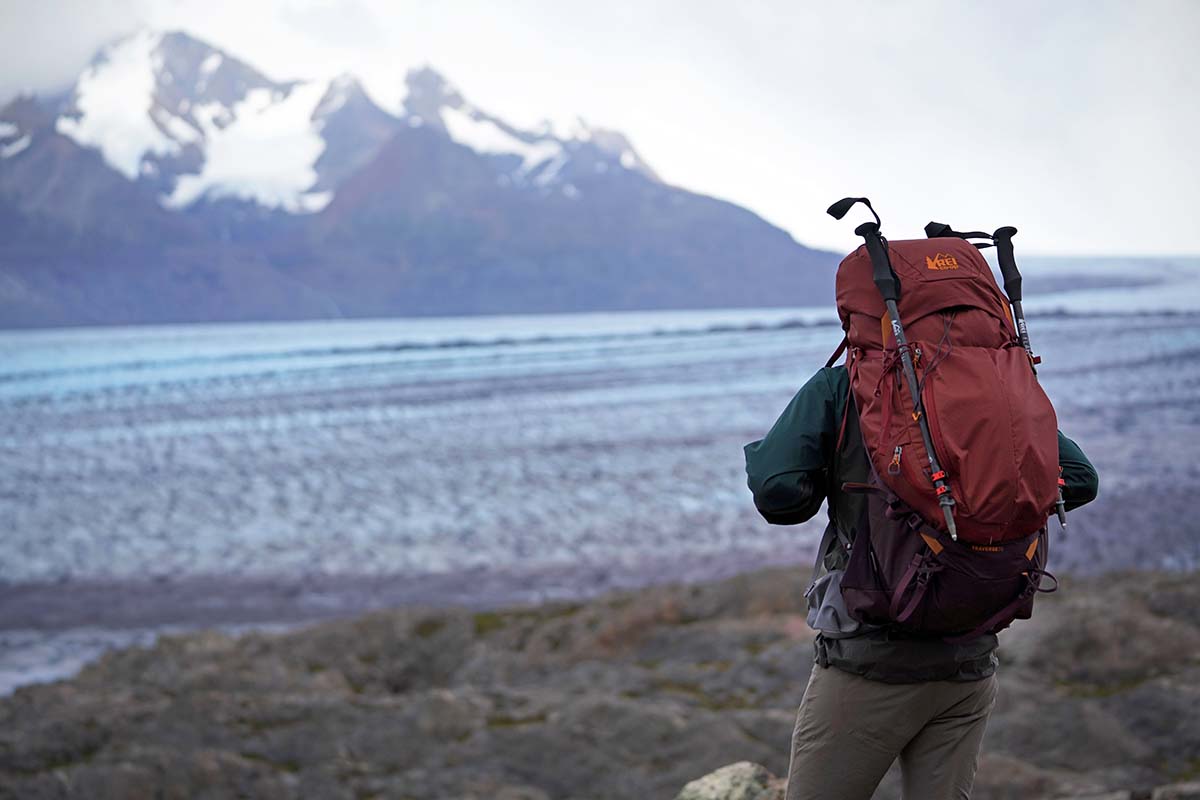
Black Diamond pioneered the ultralight folding category with their Z-Pole line. Much similar the poles that come with a tent, yous can separate the pieces and pack them down into a compact size (oft 10 inches shorter than a comparable telescoping pole). More than recently, Leki has made a stiff push with their Micro Vario series, which includes the Micro Vario Cor-Tec TA above and pricier Micro Vario Carbon (not listed hither). Most folding poles have very thin shafts, tin can behave less weight than their telescoping counterparts, and are either non adjustable or limited in their adjustments lengthwise. Favored by fast hikers, trail runners, climbers, and travelers, these poles will cause the least amount of arm fatigue over long miles.
A third category of trekking pole is the straight-shaft, fixed-length design. These are relatively uncommon because information technology can be difficult to shop or send such a long particular (especially when fastened to your pack or in a suitcase), and they can't be adapted for upward and downhill travel. As such, no fixed-length poles made our list. If you're in the market, however, nosotros recommend checking out the Ultimate Direction FK, which weighs just 4 ounces per pole.
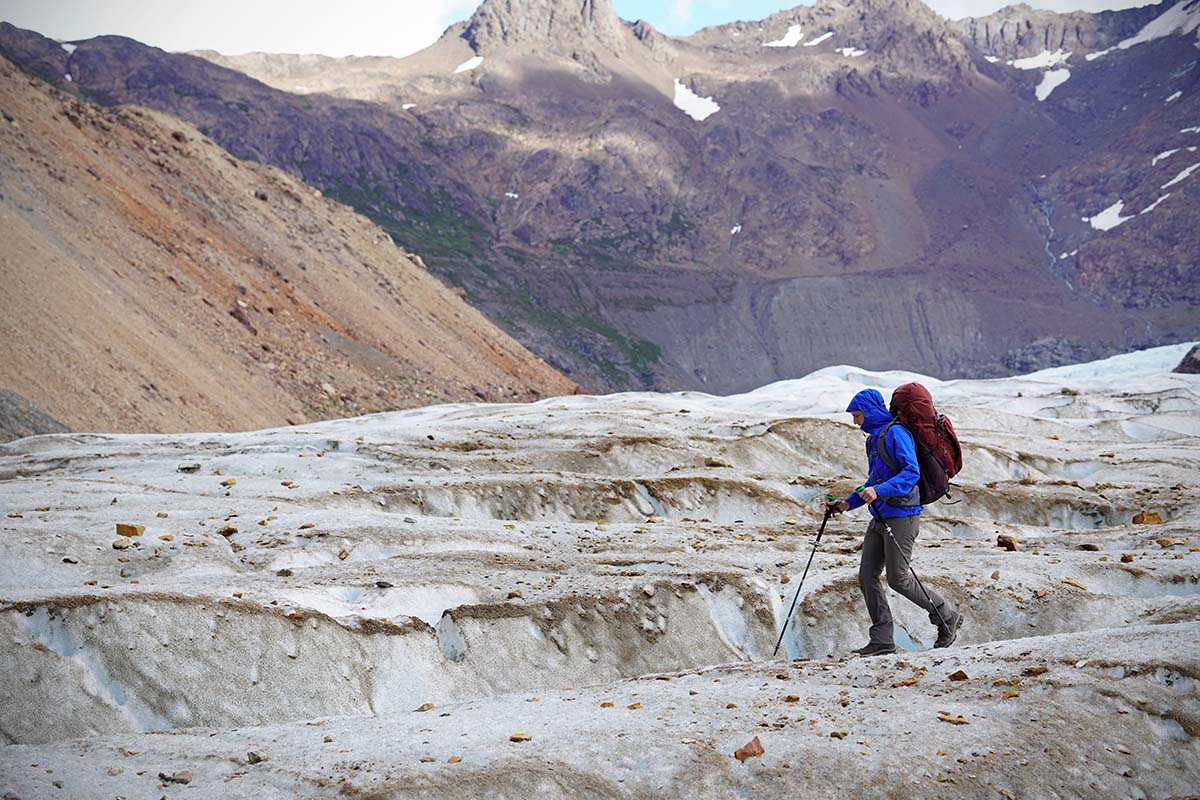
Shaft Materials
Generally, hiking poles are made either from carbon fiber, aluminum, or a combination of the two (a three-section pole may have two carbon upper pieces and an aluminum lower, for example). High-end trekking poles are frequently fabricated from carbon, which is lighter and stiffer but also more expensive and brittle (and when carbon fiber breaks, it breaks; aluminum may merely dent or bend and however be usable). Carbon's tendency to snap under hard stress can exist somewhat offset by a thicker diameter structure, at the penalisation of weight.
Price and overall immovability are the main reasons hikers opt for aluminum poles. There'due south something to be said near a confidence-inspiring design like the Blackness Diamond Trail Ergo, which is super stable and has most no wobble even on steep descents. In the terminate, the casual hiker or someone that is rough on their gear will probably be happiest with an aluminum or hybrid aluminum/carbon pole. On the other hand, an all-carbon build remains the best choice for the weight-focused hiker/backpacker.
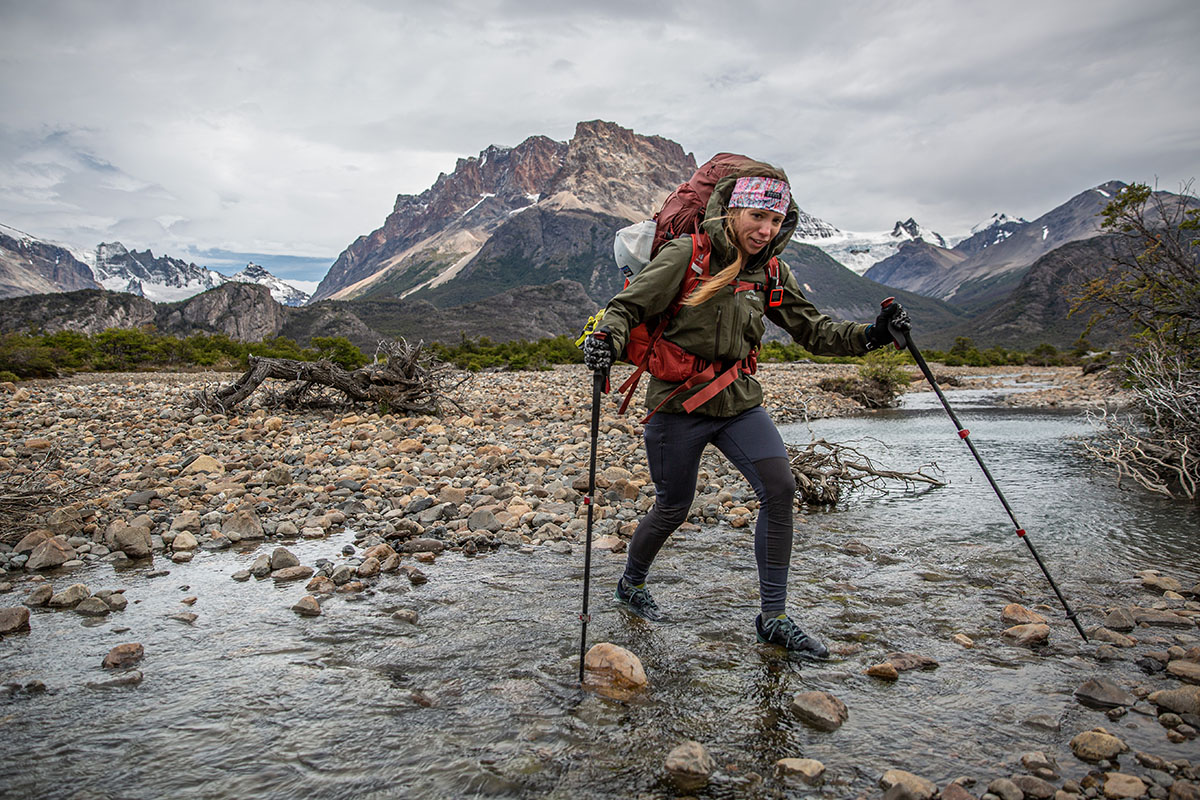
Locking Mechanisms
Outside of an ultralight folding trekking pole, chances are y'all'll exist eying one with some sort of locking mechanism. The archetype style used a twist lock: To tighten, yous twist each section closed to lock the segments into place. These poles are haunted by inconsistent performance, with hikers either over-tightening to the point of seizing, or twisting too loose, resulting in perpetual issues with collapsing. Needless to say, the twist lock has gone out of vogue. And while there are a few models out there that do a proficient job—such as what you go on Gossamer Gear's LT5—we typically recommend avoiding the twist lock.
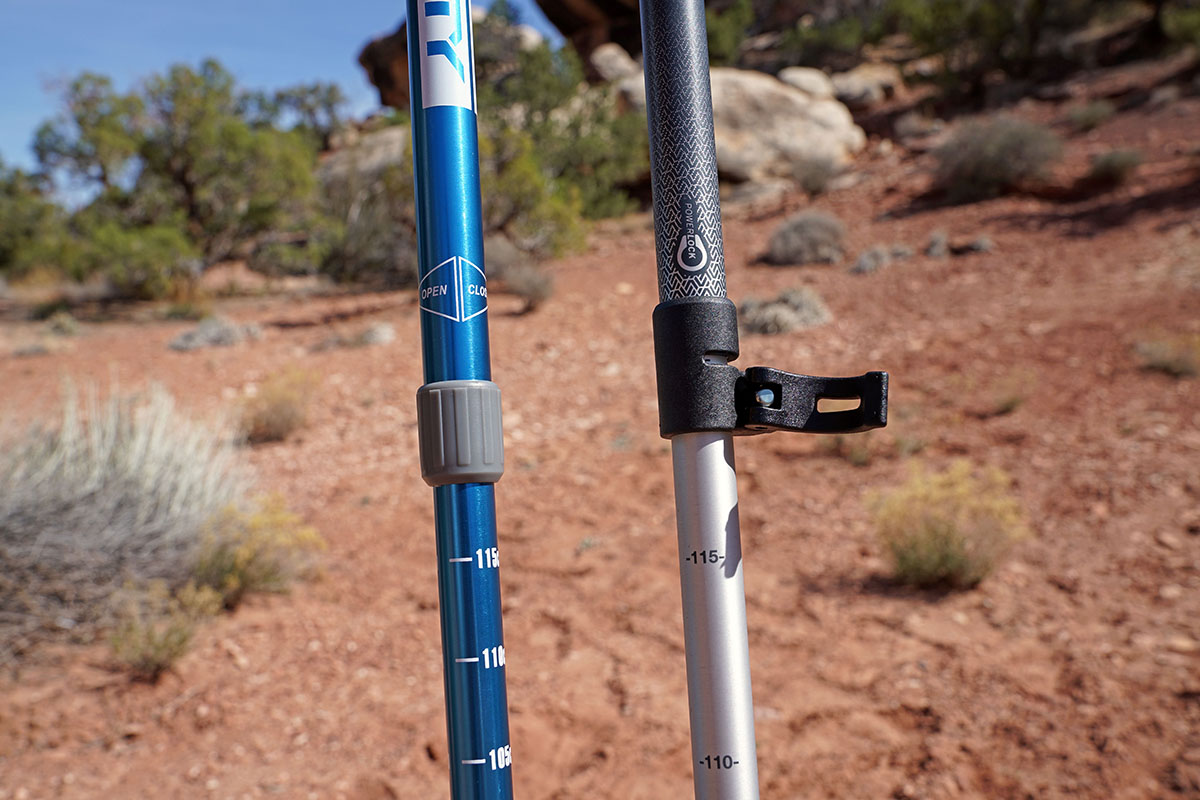
Enter the lever lock. Using an external clamp to either open to accommodate or close to lock the pole sections, information technology'due south an easy-to-utilise system. Meliorate nonetheless, the tendency for segments to sideslip when in the locked position is significantly reduced, giving additional confidence to the user. There are yet a few risks of incidentally opening the lock when moving through heavy brush or the need to occasionally tighten the lever with a screwdriver (Leki's SpeedLock + on the Micro Vario Cor-Tec TA doesn't crave a tool to accommodate), but these are minor nitpicks. The lever lock is the new standard.

Trekking Pole Grip Structure
Materials: Cork, Foam, and Rubber
Trekking pole grips come in three main types: cork, foam, and rubber, with cork beingness our personal favorite. A quality cork handle has an exceptionally comfortable experience in the paw and wicks sweat very well. It also will conform nicely to your hand over time, making information technology great for long-altitude treks and multi-season use. If cork isn't your thing, the next best bet is foam. EVA foam is soft, provides a measure of daze absorption, and does a decent job at wicking moisture in the summer months (although it will typically retain more moisture than cork). Rubber is the tertiary option and usually institute on budget hiking poles. Nosotros've plant these grips to exist all-time for cold weather condition activities considering they shed pelting and snow, but they lack the sweat absorption and premium feel of foam and cork.
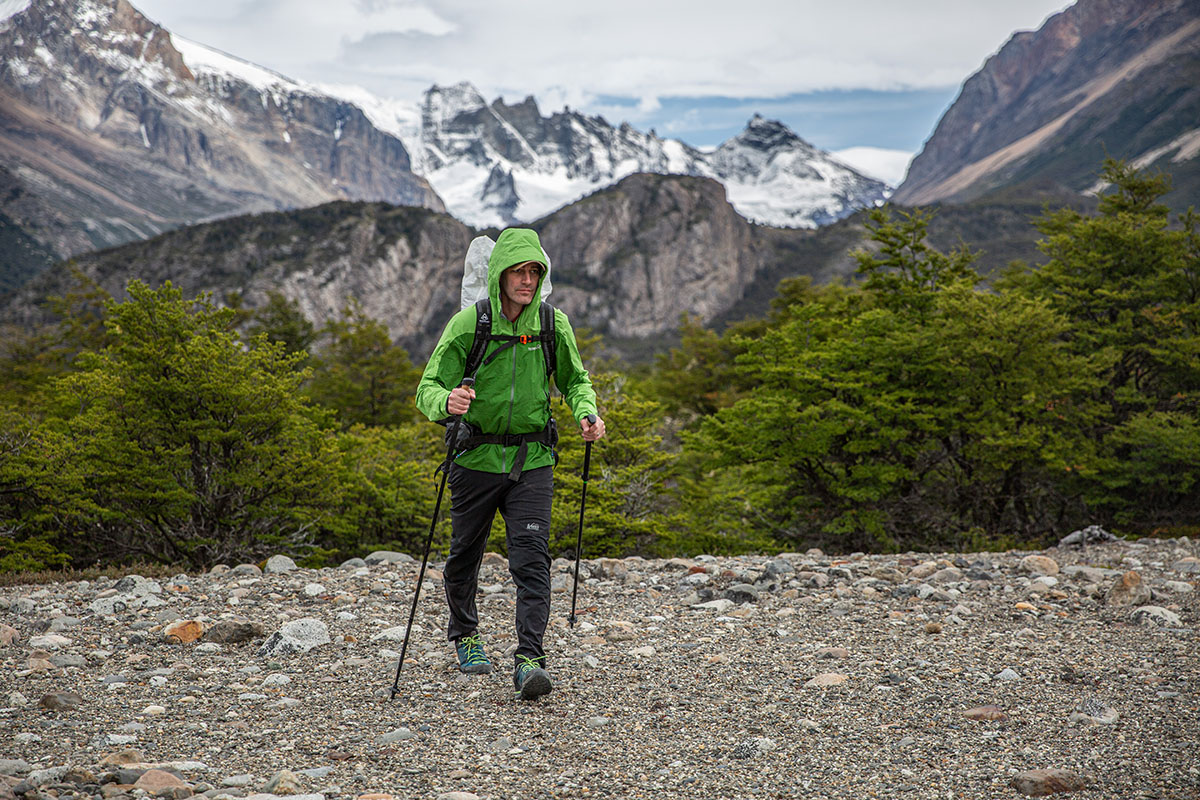
Ergonomic Handle vs. Standard Handle
Looking beyond the grip materials, another consideration is whether or not to get an ergonomic handle. These types of grips have a slight forrard angle, typically around xv degrees, which is supposed to mimic where your easily would naturally rest. Non surprisingly, what feels "natural" to 1 person may not to another, and this in the end is a very personal choice. That being said, we've enjoyed our fair share of ergonomic grips (Leki is a standout in this expanse, and nosotros also similar Black Diamond's Ergo models).
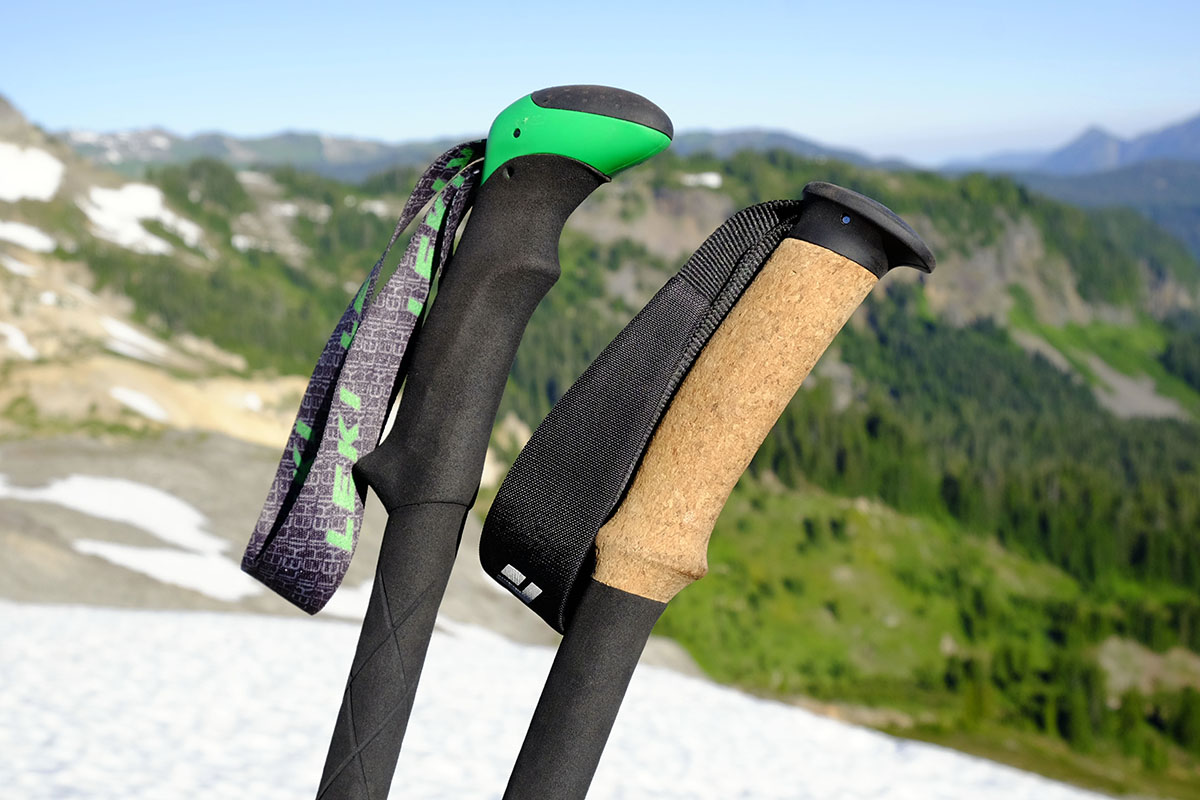
Choke-up Extensions
Many poles will have a second, smaller grip below the principal ane. This is what we refer to as a choke-up extension, or extended grip. These predominantly foam grips are great for finding a secure hold lower on your poles while climbing steep hills or sidehilling, improving balance and leverage. For those who often travel on steep or technical terrain, extended grips are a must-accept feature. For a DIY culling, you can wrap duct tape around your poles nether the large grips for a more than secure hold.

Wrist Straps
The last slice in the grip construction is the wrist strap. There is an impressive diversity of strap designs, ranging from heavily padded to simple nylon. And some hikers ditch the straps altogether considering they'd rather non be connected to their poles should they take a fall or use the system improperly (correct technique is entering from the bottom opening of the strap). In choosing a strap, the biggest consideration is noticing any potential irritants. If a seam is rubbing against the dorsum of your manus on a short walk, that can plow into serious chafing by mile 10. In general, the straps on most quality trekking poles are very comfortable. Even the simple webbing on the Leki Micro Vario Cor-Tec TA is very smooth. At the other end of the spectrum, you get well-nigh total hand coverage with Leki'south MCT Superlite, but many hikers and backpackers volition find the design overkill and a bit polarizing.
Weight
The weight of the trekking poles is our second biggest consideration (first is comfort), and we wouldn't blame you for putting information technology atop your priority listing. A light pole will fatigue your artillery less quickly, which is a big do good on long treks. On short trips, you lot may not find a 2-ounce deviation, but when y'all think of the number of times your artillery swing forward over an extended trip, it'south easy to realize how a little weight savings tin get a long way.
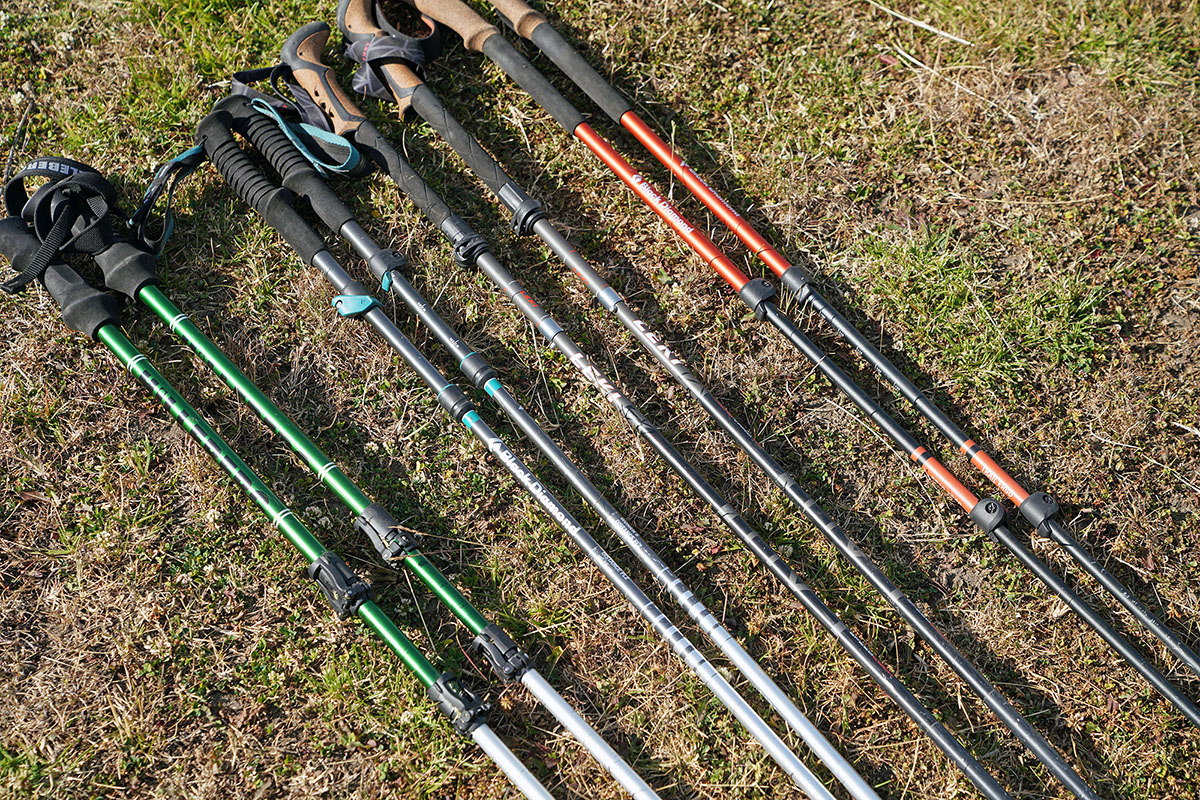
For moving low-cal and fast, the lighter the better, with a caveat that durability diminishes once you become into the ultralight category (we run across it happen right effectually 1 pound). On the extreme end are poles like the Gossamer Gear LT5 (x.6 ounces for a pair) or Black Diamond Distance Carbon Z (9.iii to 10.4 ounces, depending on length). These are bully for ultralight backpackers and thru-hikers, simply the shaft materials are besides delicate for bushwhacking or 4-flavour apply. Our preference is to become lightweight without having to be constantly worried about snapping the poles, which is why we rank the BD Trail Ergo atop our list.
.jpg)
Packed Size
Packed size or collapsed length isn't a brand-or-break specification for us, but information technology is a consideration for travelers that need to fit their poles into a suitcase and hikers that strap their poles to their pack. Folding poles have the prize for the smallest packed size, which is as picayune every bit xiii inches. Properly protected, they're even pocket-sized plenty to shop inside a daypack.

Non anybody puts such a high value on a compact size, which is partly why iii-section poles remain the most pop style on the marketplace. Their average minimum length is 24 to 27 inches, which is small enough to attach to the outside of a backpacking pack, and as well can fit into well-nigh baggage. 2-department telescoping designs are where it may get an issue for squeezing into a duffel or suitcase, and y'all can forget nigh traveling with a stock-still-length pole.
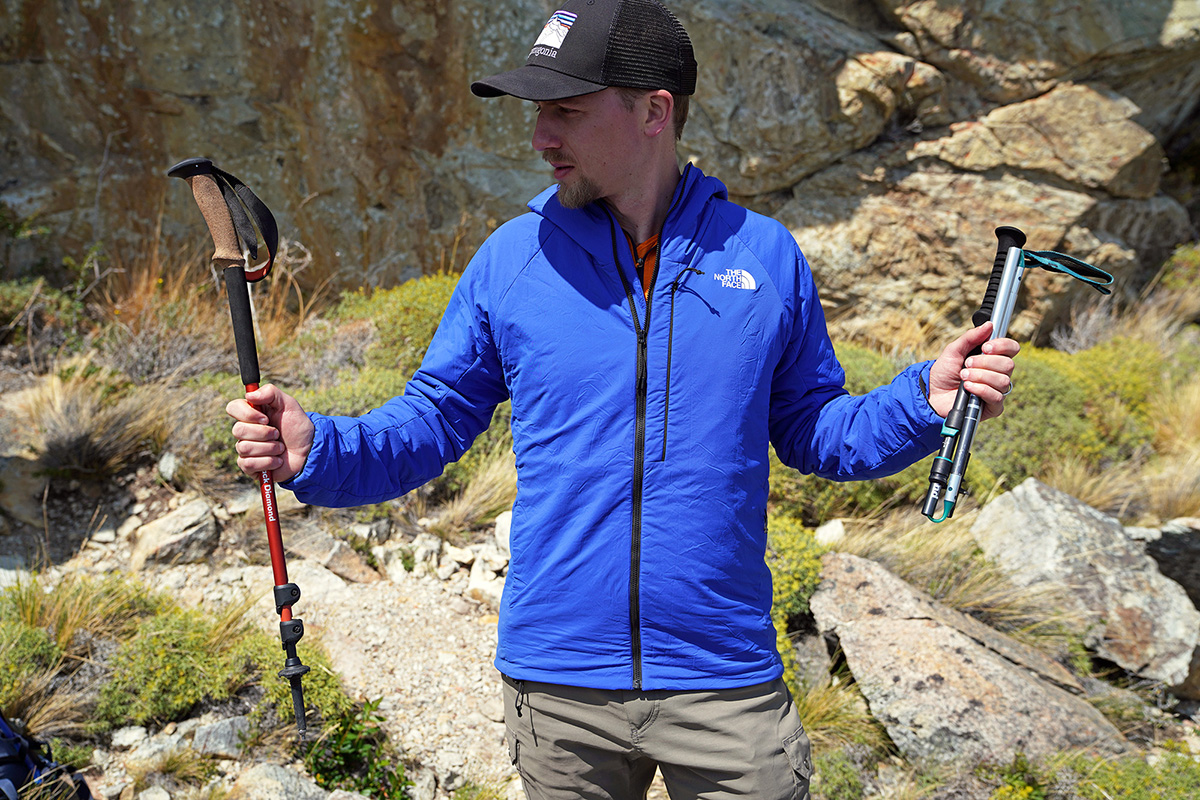
Durability
For trekking poles, immovability and weight almost e'er get manus in hand. The outset places manufacturers expect to cut weight are the thickness of the material and the diameter of the pole. A smaller bore and thinner pole logically will exist less durable and flex more than under force per unit area than its wider and thicker counterpart. The other function of the equation is the material itself. Every bit mentioned above, even though aluminum may not be as strong every bit carbon fiber, it is the better selection in terms of durability because it has a lesser chance of breaking. This is why some manufacturers make a hybrid carbon and aluminum pole with the aluminum section at the bottom. Banging up against trail debris or snagging the pole in between rocks may only dent or bend the aluminum rather than scissure or shatter the carbon.

As with any slice of outdoor gear, it's best to think through your private needs. Because we like to use our trekking poles yr-round and on varied terrain, we're willing to deal with the extra couple ounces to become a more reliable build similar the proven Black Diamond Trail Ergo Cork. But if nosotros were setting off on a thru-hike of the PCT, nosotros'd be willing to compromise a lot more than on durability.

Winter Apply
To keep your gear closet from overflowing (and your bank account plentiful), it's always nice to find a unmarried slice of gear that tin can be used year-round. A durable trekking pole can exist simply that: bully for simple day hikes or backpacking trips in the summertime, but burly enough for snowshoeing or even the occasional ski bout. So what makes a trekking pole suitable for wintertime? Typically it will come up from the telescoping category. The stiffer design and telescoping function is of import for uphill and downhill travel, especially for skiing or mountaineering. That said, there are some robust folding poles like the Black Diamond Tall FLZ
Beyond having a stiff shaft material, interchangeable baskets are a must for winter use. Many trekking poles come with, or offer as an accompaniment, pulverisation snow baskets. The wide diameter baskets keep the poles from sinking in deep snow, just like a ski pole. Not all trekking poles have this selection, yet, then make sure to verify prior to purchasing.
.jpg)
Shock-Absorbing Poles
Adding shock absorption to trekking poles seems similar a no-brainer. They have the built-in give that takes additional stress off of knees equally well equally your wrists on a long descent. Simply, a quick scan of the picks in a higher place will show only a few poles with shock absorption made our list. What gives? Showtime and most importantly is the extra weight. On longer treks, those additional ounces really count (although the Leki system just adds 1 ounce per pole). Most importantly, simplicity in the outdoors is your friend, and one fewer office to interruption is a win for u.s.a.. There are undoubtedly good reasons to go a stupor-absorbing pole, merely we encourage you to think through the compromises to make certain they're worth it.
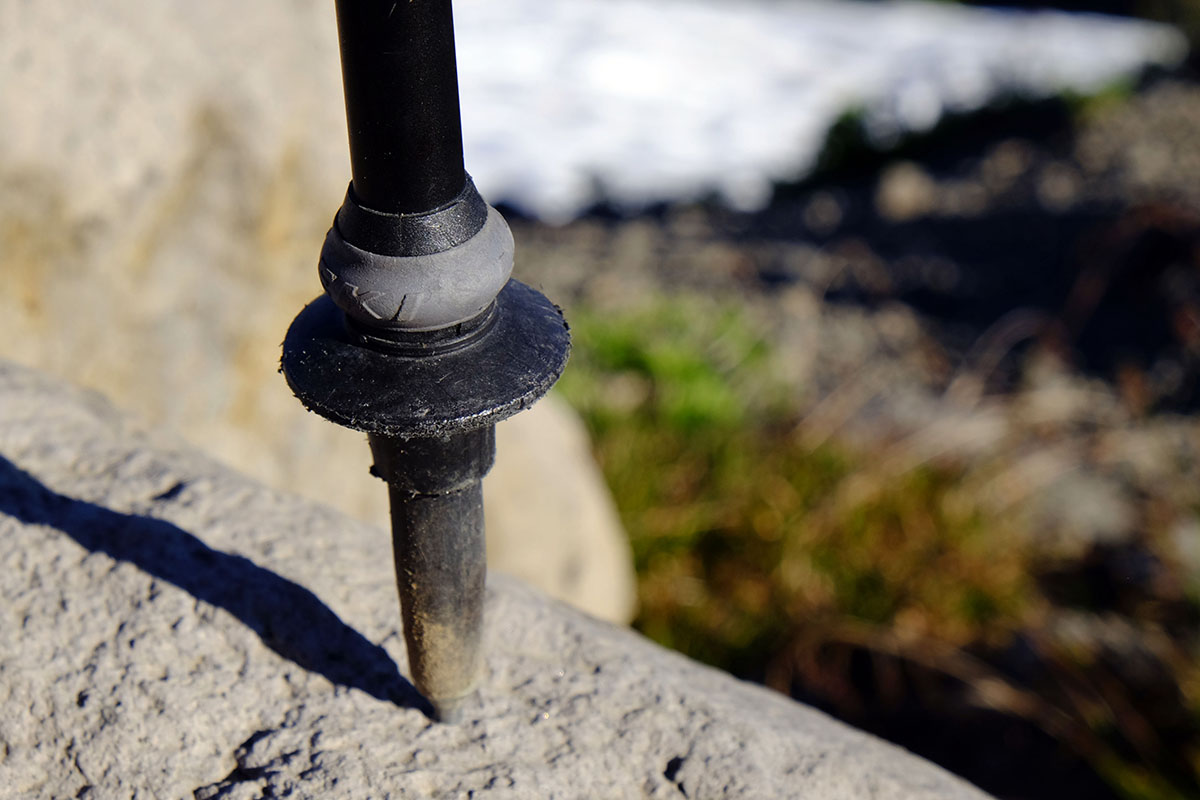
Women'southward-Specific Trekking Poles
Nearly trekking poles are billed as unisex products, simply there are a number of models that include a women'south version (Leki also has an entire collection of women's-specific poles). What differentiates the women's trekking pole is a narrower bore grip, intended for smaller hands, and a shorter maximum length. For reference, the women'due south version of the BD Trail Ergo Cork tin be extended to 49 inches, while the men'southward extend to 55 inches. Realistically, anyone that doesn't need the extra length and would benefit from the smaller-diameter grips should choose a women's trekking pole. Another benefit is women'due south poles have a shorter minimum length (typically around 4-5 inches shorter in telescoping models), which makes them easier to stow abroad in a suitcase for traveling.
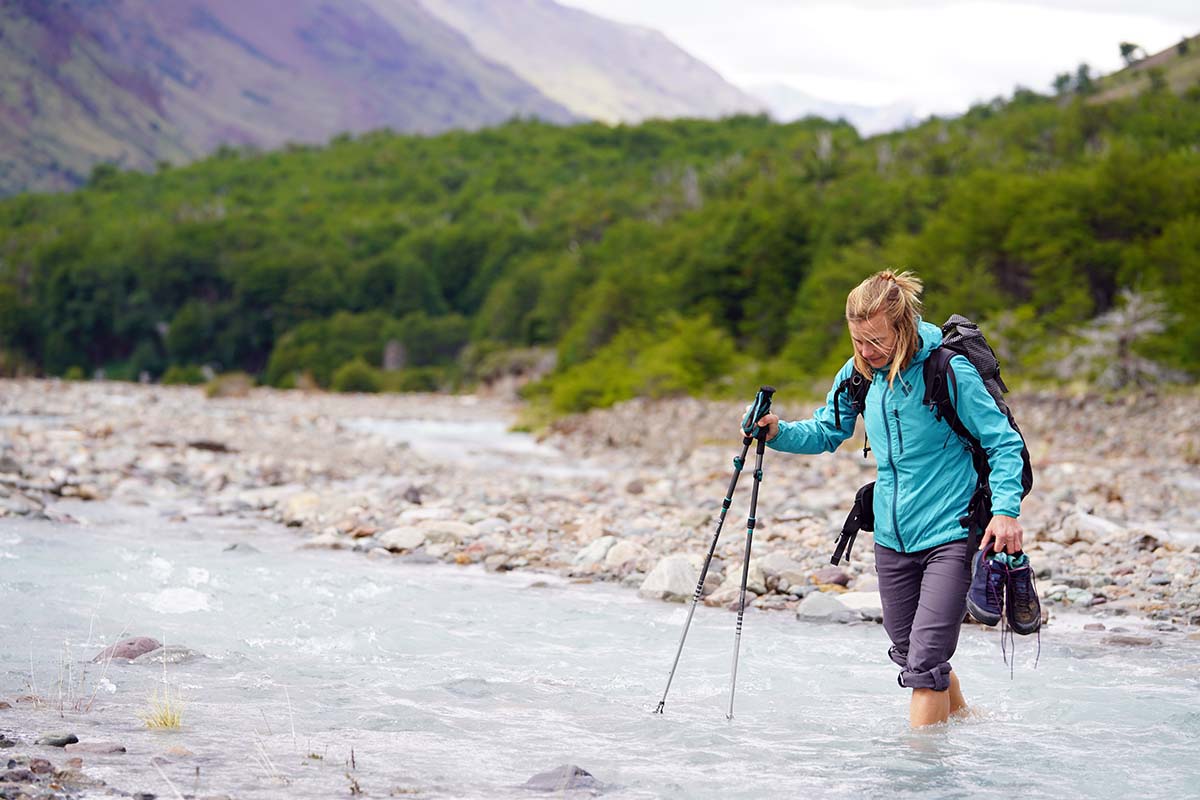
Cheap Trekking Poles
Uncomfortable cream, cork disintegrating into your palms, wrist straps chafing your hands, frail locking mechanisms collapsing. Demand we go along? A poorly made, cheap trekking pole is just not worth information technology. Now we're not saying you lot accept to spend $150 to feel safe and secure; there are a number of poles under $100 that we notwithstanding highly recommend. Moreover, if you are looking for a trekking pole for stability effectually boondocks or want to try them without paying through the olfactory organ, you can forego some of the fancy lightweight features and go a classic aluminum pole at a reasonable cost.
The REI Co-op Trailbreak telescoping poles (#2 on our listing) are a great deal at $seventy and will do the play tricks for easy local trails and solar day hikes. If you lot plan to use the poles for backpacking, we still recommend sticking with the pricier options on the list. As with virtually items you get for the backcountry, it'south well worth it to get a piece of gear you can rely on.
.jpg)
Hiking with One Trekking Pole
Although the vast majority of hikers employ two trekking poles, it's worth mentioning that a certain contingent prefers one. We've found that this is about often thru-hikers who want to carry the to the lowest degree possible weight and gear, and 1 pole does afford you added balance and support compared to not using whatsoever at all. For those using an ultralight shelter with trekking pole support, manifestly the design will demand to require only one pole. For example, well-nigh Hyperlite Mountain Gear shelter models require 1 pole, while pop ultralight tents like the Zpacks Duplex crave one pole on each stop (two full). In the stop, the selection comes downwards to personal preference, and ane pole can be a fine option for those who want some of the benefits while keeping a hand gratuitous. And in terms of buying, almost all hiking poles are sold in sets, although the Mountainsmith Dolomite to a higher place is a notable exception. Further, some cottage brands like Gossamer Gear do let you lot to order one by including a note to "transport only 1 pole and refund 50%".

Trekking Pole Tents and Shelters
For ultralight backpackers and thru-hikers, a trekking pole-supported shelter is a not bad manner to trim weight. If y'all're because one of these designs, keep in mind you'll need a uniform set of poles. One central factor is pole length, and many shelters are designed to office with set dimensions. For example, Zpacks' popular Duplex works with poles approximately 48 inches long, while Gossamer Gear's The 1 is best with two 49-inch poles. In improver, we've plant adaptable pole designs simplify the set-upwardly process (stock-still-length poles are cumbersome and harder to get in place). Finally, the durability of your trekking poles is important: Ultralight carbon models may exist great while hiking, but if they snap, you'll need to become creative to make your shelter functional. For us, a balanced design like the Black Diamond Distance FLZ makes a lot of sense. It's reasonably low-cal at 14.8 ounces per pair, sturdy and tough with its aluminum build, and the adjustable length ensures the Distance FLZ will fit with almost shelters on the market.
Dorsum to Our Top Trekking Pole Picks Back to Our Trekking Pole Comparison Table
youngbloodwitally.blogspot.com
Source: https://www.switchbacktravel.com/best-trekking-poles
0 Response to "Review Hi-tec Whistler Anti Shock Trekking Hiking Poles"
Post a Comment